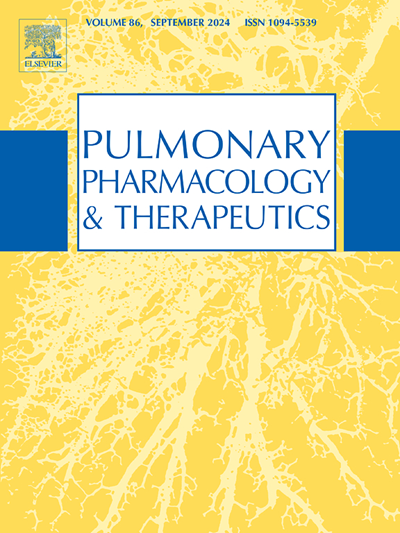The low global warming potential propellant HFA-152a does not induce bronchoconstriction or impair mucociliary clearance
IF 2.8
3区 医学
Q2 PHARMACOLOGY & PHARMACY
引用次数: 0
Abstract
Introduction
Use of propellants with high global warming potential (e.g., HFA-134a) for pressurised metered-dose inhalers is being phased down. An alternative is reformulation using propellants with low global warming potential (e.g., HFA-152a), which requires evaluation of the propellant's safety, in particular whether it induces bronchoconstriction or impairs mucociliary clearance (MCC). In this manuscript, we describe two studies, the first comparing the bronchoconstriction potential of HFA-152a vs HFA-134a, the second comparing their effect on MCC.
Methods
The bronchoconstriction study was single-dose, randomised, double-blind, controlled, crossover, in adults with asthma. The primary endpoint was relative change from baseline in forced expiratory volume in 1 s (FEV1) at 15 min post-dose.
The MCC study was multiple-dose (8 days), randomised, open-label, controlled, crossover, in healthy volunteers. The primary endpoint was percent particle retention in the right whole lung at 2 and 4 h after inhalation of radiolabelled particles (PPR2 and PPR4).
Results
For the bronchoconstriction study (N = 25), the 95 % CI of the adjusted mean FEV1 difference between HFA-152a vs HFA-134a at 15 min post-dose was within the −10 % to +10 % equivalence limit (1.86 % [95 % CI –0.48 %, 4.20 %]; p = 0.113). Treatment-emergent adverse events were reported by 4.0 % (HFA-152a) and 12.0 % (HFA-134a) patients, all mild or moderate in intensity, and none serious.
For the MCC study (N = 20), the 95 % CIs for the adjusted mean differences between HFA-152a vs HFA-134a at Day 8 contained 0 for both PPR2 (1.36 [–2.28, 4.99]%; p = 0.442) and PPR4 (0.70 [–1.73, 3.12]%; p = 0.553). A similar proportion of subjects had treatment-emergent adverse events (25.0 % vs 35.0 %), all mild in intensity, and none serious.
Conclusions
These two studies suggest a switch in propellant from HFA-134a to HFA-152a is unlikely to induce post-dose bronchoconstriction in asthma or impact lung MCC, and is not accompanied by any safety concerns.
低全球变暖潜势推进剂HFA-152a不会引起支气管收缩或损害纤毛粘膜清除。
导语:正在逐步减少在加压计量吸入器中使用具有高全球变暖潜能值的推进剂(例如HFA-134a)。另一种选择是使用具有低全球变暖潜能值的推进剂(例如,HFA-152a)重新配制,这需要评估推进剂的安全性,特别是它是否引起支气管收缩或损害黏毛清除(MCC)。在本文中,我们描述了两项研究,第一项比较了HFA-152a与HFA-134a的支气管收缩电位,第二项比较了它们对MCC的影响。方法:支气管收缩研究采用单剂量、随机、双盲、对照、交叉试验,纳入成人哮喘患者。主要终点是给药后15分钟1秒用力呼气量(FEV1)相对于基线的相对变化。MCC研究采用多剂量(8天)、随机、开放标签、对照、交叉,在健康志愿者中进行。主要终点是吸入放射性标记颗粒(PPR2和PPR4)后2和4小时右全肺颗粒保留率。结果:在支气管收缩研究中(N=25), HFA-152a与HFA-134a在给药后15分钟调整后平均FEV1差异的95% CI在-10%至+10%等效极限内(1.86% [95% CI -0.48%, 4.20%];p = 0.113)。4.0% (HFA-152a)和12.0% (HFA-134a)患者报告了治疗中出现的不良事件,均为轻度或中度,无严重事件。对于MCC研究(N=20), HFA-152a与HFA-134a在第8天调整后的平均差异的95% ci在PPR2中均为0 (1.36 [-2.28,4.99]%;p=0.442)和PPR4 (0.70 [-1.73, 3.12]%;p = 0.553)。相似比例的受试者出现治疗后出现的不良事件(25.0% vs 35.0%),均为轻度,无严重事件。结论:这两项研究表明,将推进剂从HFA-134a转换为HFA-152a不太可能诱导哮喘剂量后支气管收缩或影响肺MCC,并且不伴有任何安全性问题。
本文章由计算机程序翻译,如有差异,请以英文原文为准。
求助全文
约1分钟内获得全文
求助全文
来源期刊
CiteScore
6.20
自引率
0.00%
发文量
41
审稿时长
42 days
期刊介绍:
Pulmonary Pharmacology and Therapeutics (formerly Pulmonary Pharmacology) is concerned with lung pharmacology from molecular to clinical aspects. The subject matter encompasses the major diseases of the lung including asthma, cystic fibrosis, pulmonary circulation, ARDS, carcinoma, bronchitis, emphysema and drug delivery. Laboratory and clinical research on man and animals will be considered including studies related to chemotherapy of cancer, tuberculosis and infection. In addition to original research papers the journal will include review articles and book reviews.
Research Areas Include:
• All major diseases of the lung
• Physiology
• Pathology
• Drug delivery
• Metabolism
• Pulmonary Toxicology.

 求助内容:
求助内容: 应助结果提醒方式:
应助结果提醒方式:


